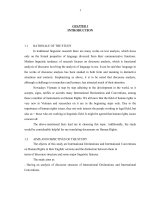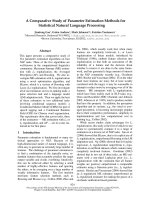A comparative study of discourse structures and some major linguistic features of international declarations and international conventions on human rights part 2
Bạn đang xem bản rút gọn của tài liệu. Xem và tải ngay bản đầy đủ của tài liệu tại đây (138 KB, 6 trang )
acknowledgements
First of all, I would like to express my deep gratitude to Assoc. Prof. Dr Hoang Van Van, my
supervisor, for his valuable guidance, advice and suggestions in writing this thesis.
I also would like to note that I am truly thankful to all the lecturers at Postgraduate Department
of CFL, VNU for their enthusiasm during my M.A. course.
Lastly, I wish to thank the family members and friends of mine for their constant
encouragements and supports.
i
TABLE OF CONTENTS
Page
ACKNOWLEDGEMENTS i
TABLE OF CONTENTS ii
ABBREVIATIONS vi
Chapter I: Introduction
1.1 General introduction 1
1.2 Aims and Objectives of the study 1
1.3 Scope of the study 2
1.4 Method of the study 2
1.5 Organization of the study 3
Chapter II: literature review
2.1 Discourse and discourse structure 4
2.1.1 Discourse 4
2.1.2 Discourse Analysis 4
2.1.3 Discourse structure 5
2.1.3.1 What is discourse structure? 5
2.1.3.2 Two views of discourse structure: as product and as process5
2.1.4 Thematization 6
2.2 Some major linguistic features 6
2.2.1 Modality 6
2.2.2 Active and Passive voices 7
2.2.3 Kinds of Sentence 7
2.2.4 Special Words/ Phrases 8
2.2.5 Speech acts 9
ii
CHAPTER III
THE DISCOURSE STRUCTURE AND SOME MAJOR LINGUISTIC FEATURES
OF THE INTERNATIONAL DECLARATION ON HUMAN RIGHTS
3.1 Definition of an International Declaration 10
3.2 Purposes and typical legal characteristics of the International 10
Declaration on Human Rights
3.2.1 Purposes 10
3.2.2 Typical legal characteristics 10
3.3 A study of the discourse structure and some major linguistic features
of the International Declaration on Human Rights 11
3.3.1 The Beginning 11
3.3.1.1 The Title and Preamble of the Declaration and their realization 11
3.3.1.2 Remarks 12
3.3.2 The Body 13
3.3.2.1 The Body of the Declaration and its realization 13
3.3.2.2 Remarks 14
a, Use of Grammar 14
a1. Modality 14
a2. Use of Active / Passive voices 14
a3. Sentence order 15
a4. Length of sentences 15
a5. Kinds of sentences 16
b. Use of vocabulary 17
b1. Archaic words and phrases 17
b2. Technical words 17
b3. Borrowed words 17
c. Thematization 17
d. Speech acts 17
3.3.3 The Ending 18
iii
3.3.3.1 The Ending of the Declaration and its realization 18
3.3.3.2 Remarks 19
CHAPTER IV
THE DISCOURSE STRUCTURE AND SOME MAJOR LINGUISTIC FEATURES
OF THE INTERNATIONAL CONVENTION ON HUMAN RIGHTS
IN COMPARISON WITH THOSE OF THE INTERNATIONAL DECLARATION
4.1 Definition of an International Convention 20
4.2 Purposes and typical legal characteristics of the International
Convention on Human Rights 20
4.2.1 Purposes 20
4.2.2 Typical legal characteristics 20
4.3 A study of discourse structure and some major linguistic features
of the International Convention on Human Rights in comparison
with those of the International Declaration on Human Rights 21
4.3.1 The Beginning 21
4.3.1.1 The Title and Preamble of the Convention and their realization 21
4.3.1.2 Remarks 23
4.3.2 The Body 23
4.3.2.1 The Body of the Convention and its realization 23
4.3.2.2 Remarks 26
a, Use of Grammar 26
a1. Modality 26
a2. Use of Active/ Passive voices 27
a3. Sentence order 27
a4. Length of sentences 27
a5. Kinds of sentences 28
b. Use of vocabulary 28
b1. Archaic words and phrases 29
b2. Technical words 29
b3. Borrowed words 29
iv
c. Thematisation 29
d. Speech acts 30
4.3.3 The Ending 30
4.3.3.1 The Ending of the Convention and its realization 30
4.3.3.2 Remarks 30
Chapter V
Conclusion
−
Some notes oN THE similarities and differences
between international Declarations and Conventions
in terms of discourse structures and major linguistic features
5.1 Similarities 32
a, Type of discourse 32
b, Register (or Functional style) 32
c, Writing style 32
d, Linguistic features 33
e, Structure 33
5.2 Differences 34
a, Expression 34
b, Structure 34
* Typical structure of an International Declaration on Human Rights 37
* Typical structure of an International Convention on Human Rights 38
* Sources of data 39
* References 40
* ANNEX I
- Universal Declaration of Human Rights, 1948 I
- International Convention on the Rights of the Child, 1989 VII
v








